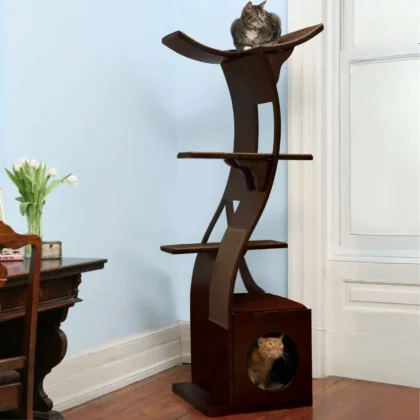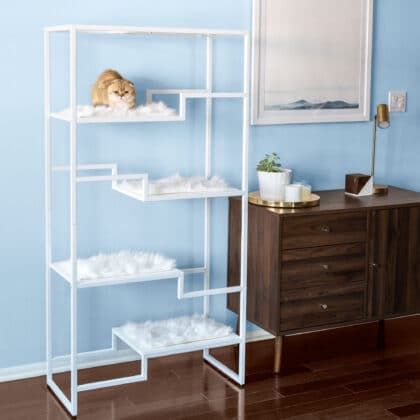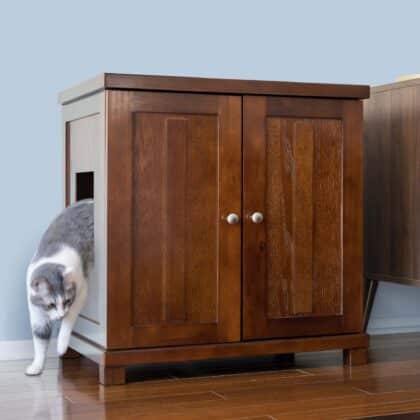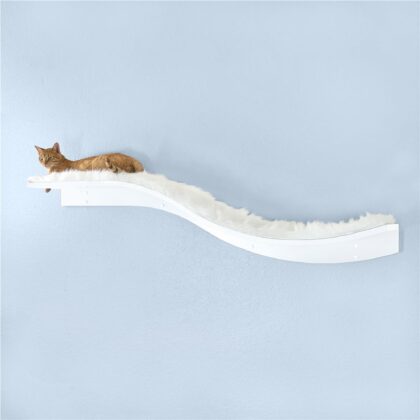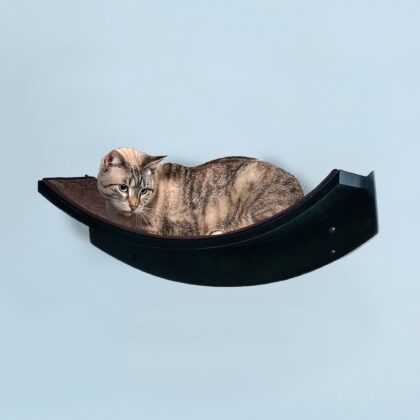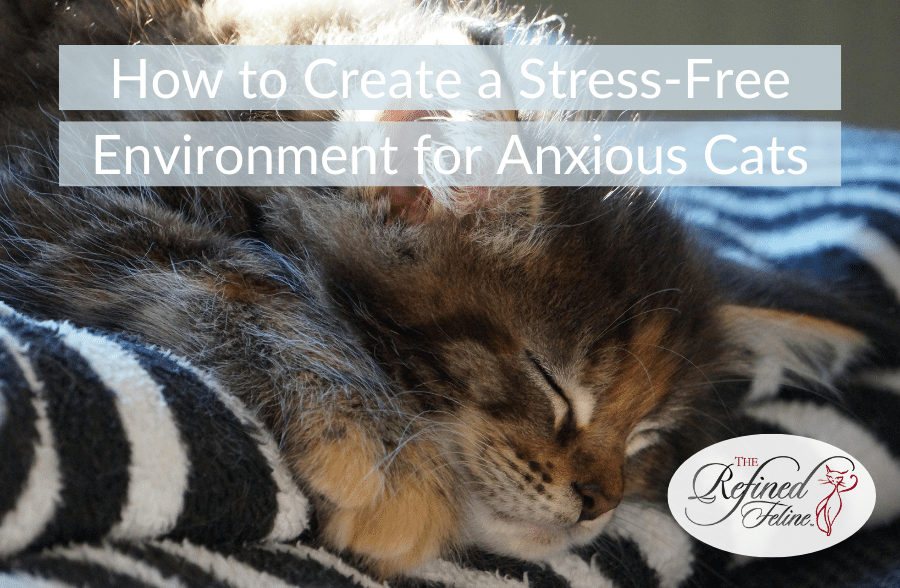
How to Create a Stress-Free Environment for Anxious Cats
Why Cats Experience Anxiety in Modern Homes
Modern living spaces often overwhelm sensitive cats. Loud noises, confined territory, unexpected visitors, and irregular schedules all contribute to cat stress and anxiety. Many owners misinterpret stress signals as personality quirks, leaving underlying issues unaddressed and untreated.
Anxiety significantly impacts feline health through decreased appetite, compulsive grooming, inappropriate elimination, and compromised immunity. Creating a structured environment with strategic escape routes, vertical territory, and calm spaces helps anxious cats rebuild confidence and achieve emotional balance.
Success comes from combining thoughtful environmental adjustments with consistent behavioral techniques—specifically customized to address your cat’s unique triggers and personality.
How to Identify the 10 Signs Your Cat is Stressed
Before implementing solutions, accurately identifying stress symptoms enables targeted intervention. Many indicators remain subtle until anxiety becomes severe.
Physical Signs of Stress in Cats
- Excessive grooming: Bald patches or irritated skin from compulsive licking
- Digestive issues: Vomiting, diarrhea, or constipation unrelated to diet changes
- Altered eating patterns: Sudden increases or decreases in food consumption
- Dilated pupils: Persistently enlarged pupils in normal lighting conditions
- Tense body language: Hunched posture, tucked tail, or rigid stance
Behavioral Indicators of Feline Anxiety
- Increased hiding behavior: Spending unusual amounts of time concealed
- Excessive vocalization: Uncharacteristic meowing, growling, or hissing
- Litter box avoidance: Eliminating outside designated areas despite no medical cause
- Heightened aggression: Swatting, biting, or hissing at familiar people or pets
- Extreme lethargy or hyperactivity: Either behavioral extreme suggests potential stress
Recognizing multiple symptoms helps determine which solutions will work best. Cats displaying several indicators typically benefit from comprehensive environmental modifications.
Creating Physical Safe Zones for Anxious Cats
Vertical Territory – Essential for Security
Cats naturally seek elevation when feeling threatened. Vertical spaces provide:
- Strategic observation points for monitoring surroundings
- Reliable escape routes from ground-level threats
- Secure resting areas away from household activity
Cat trees for small spaces deliver vertical territory without consuming limited floor area. Well-designed cat furniture creates immediate relief for anxious cats while complementing home décor rather than detracting from it.
Strategic Furniture Placement
Position cat furniture against walls rather than in open areas. Cats prefer having backs protected while surveying rooms. For apartments or small spaces:
- Wall-mounted shelves create climbing paths without floor footprint
- Multi-function pieces serve both human and feline purposes
- Corner-optimized designs utilize typically wasted spaces
The Calypso Cat Scratcher exemplifies smart design for anxious cats. Its curved shape provides a partially enclosed scratching surface where cats feel protected while engaging in stress-relieving scratching. The premium sisal material satisfies natural scratching instincts while the curved design creates a subtle hiding spot that anxious cats instinctively seek.
Hidden Retreats – Crucial for Decompression
Anxious cats need private spaces to process overwhelming stimuli. Effective hiding spots include:
- Enclosed cat beds: The Kitty Ball Cat Bed provides an ideal spherical retreat with a single entrance cats can monitor. Its elevated design keeps cats feeling secure while the plush interior creates comfort during stress recovery periods.
- Partially covered resting areas: The A-Frame Cat Bed combines an enclosed feeling with visibility. Cats can retreat inside while still monitoring surroundings—perfect for cats that become anxious when fully hidden from view.
- Multi-level structures: Furniture offering various elevations allows cats to select heights matching anxiety levels—higher perches during severe stress episodes, lower areas when feeling more secure.
Environmental Modifications to Reduce Cat Anxiety
Sound Management – Controlling Acoustic Triggers
Noise sensitivity affects many anxious cats. Consider implementing:
- Background sound masking: Gentle white noise or species-specific music composed for feline hearing
- Sound absorption: Soft furnishings reduce echoes and dampen sudden noises
- Buffer zones: Position cat furniture away from doors, windows, or appliances producing startling sounds
Scent Control – Managing Olfactory Anxiety
Cats process life primarily through smell. Help manage anxiety through:
- Pheromone diffusers: Synthetic facial pheromones mimic cats’ natural calming signals
- Consistent cleaning products: Use identical mild, unscented cleaners to maintain environmental smell stability
- Scent marking preservation: Avoid washing all bedding simultaneously—preserve some familiar scent markers
Lighting Considerations – Reducing Visual Stress
Light affects cat anxiety significantly:
- Indirect lighting: Harsh direct lights create stress—use diffused lighting sources
- Predictable light cycles: Maintain consistent day/night lighting patterns
- Gradual transitions: Sudden brightness changes trigger anxiety—use dimmers when possible
Natural Remedies and Techniques to Calm Anxious Cats
Does Catnip Relieve Stress in Cats?
Catnip affects approximately 70-80% of cats, producing a euphoric, relaxed response lasting 10-15 minutes. For responsive cats, catnip offers excellent temporary stress relief through:
- Redirected focus: Shifts attention from stressors to pleasurable sensations
- Mood elevation: Produces natural euphoria blocking anxiety
- Physical release: Encourages rolling and playing that releases muscular tension
However, some cats become overstimulated by catnip. Alternatives include:
- Silver vine: Produces similar effects for cats unresponsive to catnip
- Valerian root: Creates gentle calming effects rather than stimulation
- Chamomile: Mild calming properties (use only as veterinarian directed)
Physical Contact – Touch Therapy
How to calm a cat down from stress often involves appropriate physical interaction:
- Proper petting technique: Long, slow strokes from head to tail rather than quick patting
- Pressure therapy: Gentle wrapping in towels provides comforting pressure for some cats
- Massage techniques: Circular motions around cheeks and behind ears stimulate relaxation
- Grooming mimicry: Brushing simulates maternal grooming, triggering relaxation hormones
Activity and Play – Anxiety Prevention
Regular play reduces anxiety through:
- Energy release: Prevents buildup of stress hormones
- Positive associations: Creates joy connected to previously stressful environments
- Bonding opportunities: Strengthens human-cat relationships, increasing security
- Predictable routines: Establishes comforting structure
Interactive toys proving most effective include:
- Wand toys mimicking prey movement
- Puzzle feeders requiring focus that displaces anxiety
- Rotation systems keeping toys novel and engaging
How to Handle Special Stressful Situations
How to De-Stress a Cat After a Move
Moving ranks among most traumatic experiences for cats. Reduce post-move anxiety through:
- Creating a sanctuary room: Set up one room with familiar items before introducing the entire home
- Maintaining routine: Keep feeding and play schedules identical to pre-move patterns
- Transferring scents: Bring unwashed bedding and furniture from previous home
- Gradual exploration: Allow cat-paced discovery of new spaces rather than forced introduction
- Vertical security installation: Set up cat trees and perches immediately so cats can survey new territory from safety
The A-Frame Cat Bed works exceptionally well during transitions, providing an instantly recognizable safe space placed in the sanctuary room first, then gradually moved to permanent locations as your cat adjusts.
Calming Multi-Cat Tensions
Resource competition creates significant stress in multi-cat households. Prevent anxiety by providing:
- Multiple feeding stations separated by sight lines
- Litter boxes exceeding cat numbers by one (minimum)
- Separate vertical territories allowing each cat personal space
- Individual play sessions reducing competition
Veterinary Visit Preparation
Reduce pre-vet anxiety with:
- Carrier habituation (leave carrier out as normal furniture)
- Practice car trips without vet visits
- Scheduling appointments during quieter clinic hours
- Pheromone-sprayed towels inside carriers
How to Calm Down a Hyper Cat
Hyperactivity often signals stress rather than happiness. Address through:
Physical Energy Release
- Scheduled play sessions: Create predictable, intensive play twice daily
- Appropriate scratching outlets: The Calypso Cat Scratcher’s curved design encourages complete stretching, helping release physical tension while satisfying natural urges
- Chase toys: Laser pointers or wand toys simulate hunting, fulfilling primal needs
Mental Stimulation
Mental exhaustion calms hyperactive cats more effectively than physical tiredness alone:
- Food puzzles: Make meals engaging mental challenges
- Scent games: Hide treats or catnip toys for searching
- Training sessions: Teach simple tricks using positive reinforcement
- Rotation system: Change toys weekly to maintain novelty
Schedule Adjustment
Hyperactivity often reflects misaligned energy cycles:
- Synchronize intensive play before meal times
- Match playtime to natural dawn/dusk hunting instincts
- Create consistent daily routines mimicking natural rhythms
What Helps Anxiety in Cats Naturally
Beyond environmental modifications, consider natural approaches:
Diet and Nutrition Impact
- Consistent feeding schedule: Regular meal times create security
- Food quality: Premium ingredients support brain chemistry balance
Confidence Building Exercises
- Clicker training: Positive reinforcement builds confidence
- Controlled challenges: Gradually introducing minor stressors builds resilience
- Success experiences: Create opportunities for “wins” through accessible toys or climbing challenges
Companion Selection
Some anxious cats benefit from:
- Confident companion cats: Social learning from relaxed feline friends
- Age-appropriate playmates: Matching energy levels reduces friction
- Proper introduction protocols: Slow, controlled meetings prevent trauma
When Professional Help Becomes Necessary
Natural solutions work for mild to moderate anxiety, but severe cases require professional intervention. Consider veterinary consultation when:
- Anxiety interferes with basic functions (eating, elimination, grooming)
- Self-injury occurs from overgrooming or stress behaviors
- Aggressive responses threaten human or animal safety
- Symptoms persist despite environmental improvements
- Physical symptoms like vomiting or diarrhea accompany anxiety
Veterinarians might recommend:
- Full health screening (many medical issues manifest as anxiety)
- Short-term anti-anxiety medication during extreme situations
- Behavior modification plans
- Referral to veterinary behaviorists for complex cases
Creating a Complete Cat Comfort System
Effective anxiety management combines multiple approaches tailored to your cat’s specific needs. Consider creating a comprehensive system with:
- Safe home base: The Kitty Ball Cat Bed or A-Frame Cat Bed positioned in quiet locations
- Vertical territory: Shelves or trees allowing surveillance and escape
- Stress-relief outlets: The Calypso Cat Scratcher for physical tension release
- Routine maintenance: Regular play, feeding, and attention schedules
Combined with patience and observation, such elements create an environment where cats gradually overcome anxiety and build confidence.
Common Questions About Caring for Anxious Cats
How to care for an anxious cat?
Provide consistent daily routines, multiple hiding spots, elevated perches, and appropriate scratching surfaces like the Calypso Scratcher. Minimize environmental changes, use pheromone diffusers, and ensure food freshness with proper storage solutions like the Amber Vacuum Seal Bin. Most importantly, allow anxious cats to approach situations at comfort rather than forcing interaction.
How to relieve stress for a cat?
Create vertical territory using cat trees or shelves, provide enclosed beds like the Kitty Ball Bed, offer regular play sessions, and maintain food freshness using vacuum-sealed storage. Environmental consistency matters tremendously—keep feeding times, play sessions, and sleeping areas predictable. Consider pheromone products and anxiety-reducing music specifically designed for feline hearing ranges.
What can I give my cat to calm her anxiety?
Veterinarian-approved options include pheromone products (diffusers, sprays), L-theanine supplements, certain probiotics shown to affect mood, and catnip or silver vine for responsive cats. For severe cases, prescription medications may help, but always start with environmental modifications and natural solutions first.
How to create an enriching environment for a cat?
Combine vertical space (shelves, trees), hiding spots (enclosed beds like the A-Frame or Kitty Ball), scratching surfaces (sisal posts like the Calypso), interactive toys, puzzle feeders, and viewing perches near windows. The Calypso Cat Scratcher provides both physical release and security, while proper food storage using the Amber Vacuum Seal Storage Bin ensures consistent nutritional support.
Can cats sense human anxiety?
Yes, cats detect human anxiety through body language cues, voice tone changes, movement patterns, and possibly stress hormone scent. Human anxiety frequently triggers feline anxiety in response. Practice self-calming techniques when interacting with anxious cats, as your emotional state directly impacts feline behavior and stress levels.
Creating a truly stress-free environment requires ongoing attention to your cat’s specific needs. Quality products like the Refined Feline’s cat beds, scratchers, and food storage solutions provide essential frameworks for anxiety management, but your observation and consistent adjustments make the real difference. Watch for subtle changes in behavior, adapt your approach accordingly, and celebrate small improvements as your cat gradually builds confidence and overcomes anxiety.



